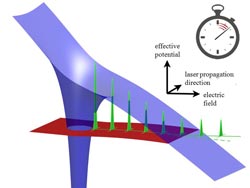Relativistic tunnelling

Fig. 1: Schematic description of tunnel ionization of highly charged ions at relativistic laser intensities. The superposition of the Coulomb potential of the atomic core and the electric field of the laser forms a potential barrier (in blue) that the electronic wave packet (in green) may tunnel through into the direction of the laser's electric component. Unlike in nonrelativistic tunnelling the ionization potential (in red) becomes position-dependent as a consequence of the laser's magnetic field. Furthermore, while tunnelling the wave packet gets shifted under the influence of ‘light pressure’ into the propagation direction fields (solid green line, see text for details).<br>
This is the result of their theoretical study on an electron that tunnels out of an atom in an intense laser field while being accelerated up near to the speed of light.
A ball running uphill will not roll over the hill if it is not given enough velocity. On atomic scales that are ruled by the laws of quantum physics, however, a particle has a non-zero chance to get onto the opposite side of a barrier even though it is not allowed to get over according to classical physics. Physicists call this effect tunnelling because it seems as if the particle forms a tunnel to pass through the barrier.
A quantum tunnelling barrier may be build up in an atom or a hydrogen-like ion by the attractive Coulomb forces that attach the electron to the atomic core and the electric field of a strong laser that pulls the electron away from the core. Metaphorically speaking the ion's Coulomb potential and the laser's electric field form a hill (a so-called potential barrier) the electron may tunnel through to ionize. For highly charged hydrogen-like ions, i.e., an atomic core with a single electron, however, ultra-strong lasers with intensities of the order of 10^18 W/cm^2 and above are required to achieve measureable ionization probabilities. Such ultra-strong lasers can no longer be treated as pure electric fields, the laser's magnetic field component has to be taken into account, too. Magnetic fields, however, do not fit into the conventional picture of a tunnelling barrier.
Therefore, it has been argued that the whole tunnelling concept may break down in the presence of magnetic fields. In Physical Review Letters, Klaiber and colleagues at the Max Planck Institute for Nuclear Physics in Heidelberg, Germany, have shown now that the notion of a tunnelling barrier can also be applied in the presence of magnetic fields of ultra-strong lasers via reshaping the potential barrier. A question that has caused many controversial discussions among physicists and remains unsolved till today is how long an electron needs to tunnel through a barrier.
Direct measurements of tunnelling times are hampered by experimental as well as conceptual difficulties. While extending the tunnelling picture into the regime of ultra-strong lasers, Klaiber and colleagues demonstrated that tunnel ionization of hydrogen-like ions via ultra-strong lasers features two time scales which may be measured indirectly. In particular, a small shift of the point of exit where the electron leaves the tunnelling barrier is caused by the presence of a magnetic field. This shift is proportional to the so-called Eisenbud-Wigner-Smith tunnelling time.
Furthermore, the magnetic field changes the velocity distribution of the ionized electrons. Ionized electrons escape with a non-zero velocity along the propagation direction of the laser that is proportional to the so-called Keldysh tunnelling time. Thus, Max-Planck-physicists related these two tunnelling times to quantities that are accessible to direct measurements in laboratory experiments. For tunnel ionization of hydrogen-like ions with small atomic numbers lasers of moderate intensities and, therefore, weak magnetic components are sufficient and the consequences of the two tunnelling time scales become small.
This may explain why experimentalists have not been able so far to measure non-zero tunnelling times in tunnelling through high barriers. By increasing the laser's intensity the height of the tunnelling barrier decreases and the shape of the barrier changes qualitatively. First calculations have given hints that in this regime the tunnelling times become relevant again and may be determined experimentally.
Original publication:
Under-the-barrier dynamics in laser-induced relativistic tunneling
Michael Klaiber et al., Phys. Rev. Lett. 110, 153004 (2013)
doi:10.1103/PhysRevLett.110.153004
Contact:
Hon.-Prof. Dr. Christoph H. Keitel
Phone: (+49)6221 516-150
E-Mail: christoph.keitel@mpi-hd.mpg.de
Dr. habil. Karen Z. Hatsagortsyan
Phone: (+49)6221 516-160
E-Mail: Karen.Hatsagortsyan@mpi-hd.mpg.de
Weitere Informationen:
http://link.aps.org/doi/10.1103/PhysRevLett.110.153004
Original publication
http://www.mpi-hd.mpg.de/keitel/
Division Keitel at MPIK
Media Contact
More Information:
http://www.mpi-hd.mpg.deAll latest news from the category: Physics and Astronomy
This area deals with the fundamental laws and building blocks of nature and how they interact, the properties and the behavior of matter, and research into space and time and their structures.
innovations-report provides in-depth reports and articles on subjects such as astrophysics, laser technologies, nuclear, quantum, particle and solid-state physics, nanotechnologies, planetary research and findings (Mars, Venus) and developments related to the Hubble Telescope.
Newest articles

Innovative 3D printed scaffolds offer new hope for bone healing
Researchers at the Institute for Bioengineering of Catalonia have developed novel 3D printed PLA-CaP scaffolds that promote blood vessel formation, ensuring better healing and regeneration of bone tissue. Bone is…

The surprising role of gut infection in Alzheimer’s disease
ASU- and Banner Alzheimer’s Institute-led study implicates link between a common virus and the disease, which travels from the gut to the brain and may be a target for antiviral…

Molecular gardening: New enzymes discovered for protein modification pruning
How deubiquitinases USP53 and USP54 cleave long polyubiquitin chains and how the former is linked to liver disease in children. Deubiquitinases (DUBs) are enzymes used by cells to trim protein…


